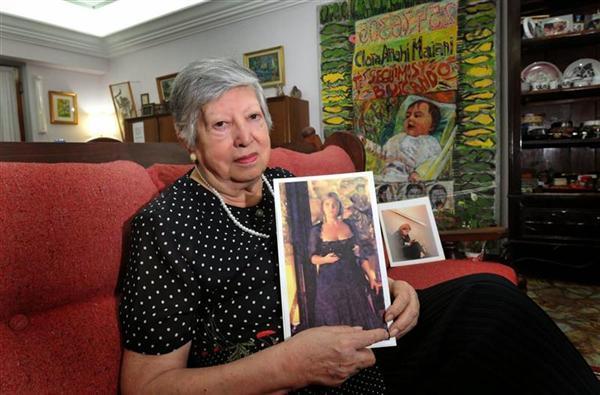|
Prosecutor: summon dictatorship-era priest
By Luciana Bertoia
Monsignor Emilio Grasselli is requested to appear in court An iconic priest linked to repression during the last military dictatorship could be summoned to sit in the dock to give explanations of his role during the 1976-1983 de facto government. Almost seven years after chaplain Christian Von Wernich was convicted to life for being involved in seven murders and more than 40 abductions, it seems that it will be Monsignor Emilio Teodoro Grasselli’s turn to appear before court. Federal prosecutor Federico Delgado requested Federal Judge Julián Ercolini to summon Grasselli, who is still a member of the Archdiocese of Buenos Aires headed by Mario Poli. The request was filed on September 16. Court sources explained to the Herald that the magistrate has three working days to make a decision. If Ercolini follows the procedural code, Grasselli could be receiving a subpoena this week. However, times are flexible for judges and Ercolini has been frequently criticized by the Kirchnerite administration for not moving forward with the case of the irregular sale of Papel Prensa newsprint company during the last military dictatorship, which ended up benefiting newspapers La Razón, La Nación and Clarín, the government’s media foe. “It’s been 30 years since the return to democracy and it is unbelievable that nobody summoned Grasselli as a suspect,” a court source told the Herald. In 2012, the Federal Criminal Oral Court Number 6 convicted late dictator Jorge Rafael Videla to 50 years in jail for being responsible of a systematic plan to snatch babies during the last military dictatorship along with other repressors and urged the courts to investigate the role played by Grasselli during the dark years of dictatorship. Federal Judges Ercolini and Sergio Torres — the latter is in charge of investigating crimes committed in the infamous clandestine detention centre that operated at the Navy School of Mechanics (ESMA) — claimed that examining Grasselli’s conduct was not within their jurisdiction until the Criminal Appeals Court put the case in the hands of the former. After 30 years, human rights activists dream of the day in which Grasselli will have to explain why he had so much information about their missing ones. Grasselli Grasselli was born in 1931 in Pujato, Santa Fe province. He was ordained in 1955, the same year when president Juan Domingo Perón was overthrown by a military coup. But it was during another dictatorship that his name became popular between mothers looking for their forcibly disappeared children or grandmothers seeking information about babies stolen from their disappeared mothers. On August 22, Alicia “Licha” Zubasnábar de la Cuadra’s granddaughter recovered her real identity. Her grandmother as many others visited Grasselli at the Stella Maris chapel, located in front of the federal courthouse located on Comodoro Py avenue. Licha asked Grasselli about her missing daughter Elena and her missing son Roberto. Grasselli told her to return in a couple of days. When she returned, the priest angered: “Why didn’t you tell me that Elena was pregnant?” His words were taken as evidence that he knew exactly where the young woman was held. Another founder of Grandmothers of Plaza de Mayo, María Isabel “Chicha” Mariani also visited the chapel and she remembered Grasselli writing notes and preparing a file with the information about her missing granddaughter Clara Anahí, snatched in November 1976. It was not only Chicha who remembers Grasselli’s file, he even explained his notes before a court when he testified as a witness. In 2011, Grasselli appeared before the Federal Oral Criminal Court Number 1 in La Plata and he acknowledged those meetings with relatives of forcibly disappeared people. “First, I started preparing a list but soon after I was overwhelmed and I started preparing a file.” In another appearance before court, he said that he started hearing about cases of disappearances and appropriations before the 1976 military coup and until 1979. In 1999, Grasselli appeared before La Plata Appeals Court to deliver his testimony in a trial for truth. Although the court had no power to issue a sentence, the judges ordered to seize Grasselli’s file, which is currently preserved as evidence. Between 1955 and 1975, Grasselli used to be Cardinal Antonio Caggiano’s private secretary but when Caggiano stepped down, Grasselli started working for Monsignor Adolfo Tortolo, the head of the Catholic Church during the first months of the dictatorship. According to Grasselli, it was Tortolo who ordered him to meet with the relatives of disappeared people. Information Conscript José David Aleksoski was abducted in 1976. His parents and sister visited the Stella Maris chapel for help. The conscript’s sister remembered that Monsignor Grasselli had a gun underneath his cassock. In 1984, he testified in court about this case, saying that he received an anonymous phone call informing that the conscript was held in the Arana clandestine detention centre, which was part of the so-called Ramón Camps repressive circuit in Buenos Aires province. According to Grasselli, he did not take many chances to provide useful information to those mothers looking for their missing children. In 1999, late Judge Alberto Durán asked Grasselli: “If you were never able to give information to anyone, why did you continue meeting with them?” Then Grasselli said that he was only able to solve a case: to find out where Mercedes Borra was. In 1985, during the trial against the Junta members, Graciela Daleo — a survivor of the ESMA concentration camp — declared that Grasselli helped her to get a visa to travel to Venezuela. She arrived at the chapel following an order from a repressor. “Grasselli testified in a trial for crimes committed at the Campo de Mayo garrison. He had links with ESMA and he also knew about the repression in the south of Greater Buenos Aires. I guess it is time he gives some explanations,” a court source concluded.
|
.
Any original material on these pages is copyright © BishopAccountability.org 2004. Reproduce freely with attribution.
